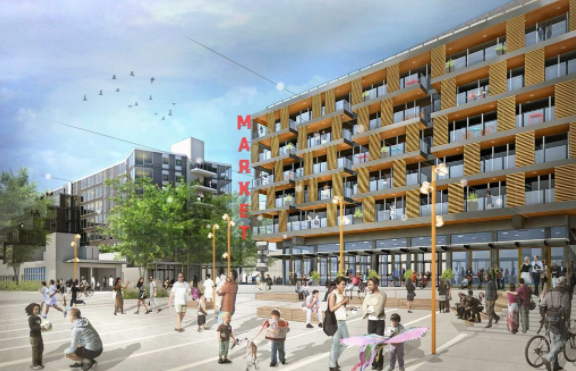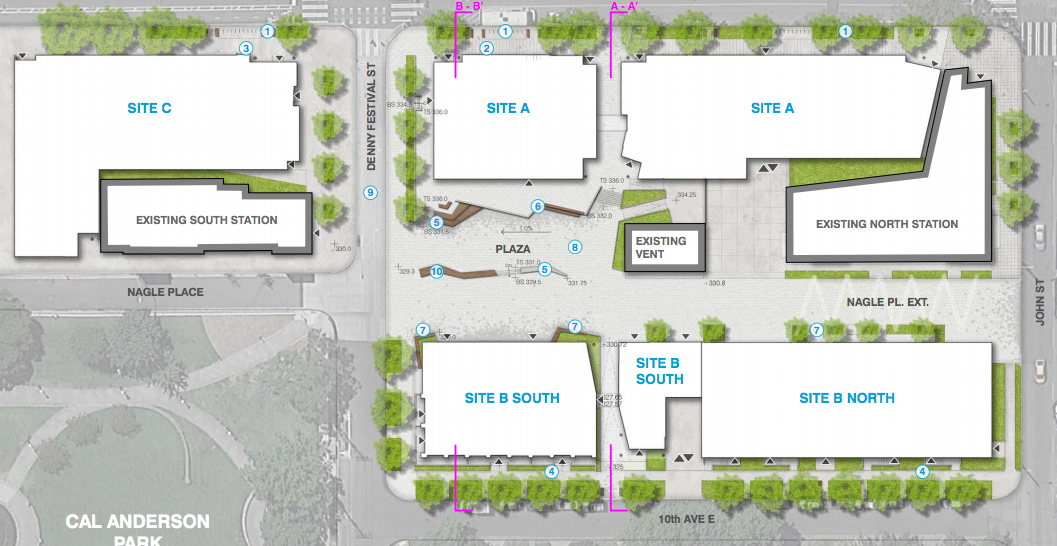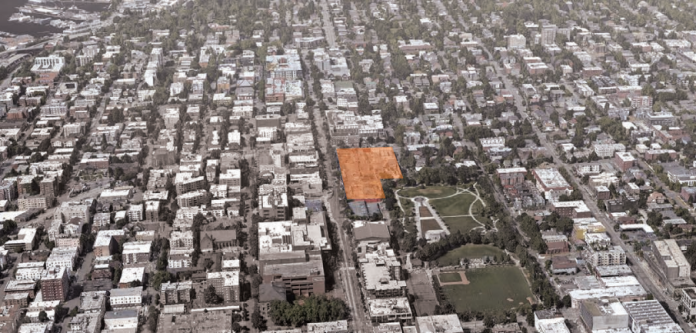Sound Transit’s Capitol Hill station marks a crucial turning point for the agency. The fruit of years of advocates pressing the agency to more robustly pursue affordable housing around its stations through the land that it has been purchasing through eminent domain, the station will be setting the model for transit-oriented development for the agency for years to come.
This fall, the agency signed a 75-year lease with the Portland developer Gerding Edlen to allow them to develop the parcels directly adjacent to the station. The deal, worth around $25 million, is a great accomplishment in that it keeps the land in public ownership rather than surplussing some of the most desirable land around one of our densest transit stations. Gerding Edlen proposes building five separate buildings on three different sites across the property, with a total of 427 residential units, as well as a substantial chunk of property for retail.
The centerpiece for the project is a central plaza, located on an extension of narrow Nagle Place between Denny Way and John Street, that will function as an extension of Cal Anderson Park and turn the Denny Way festival street into an inviting and active public gathering place.

Gerding Edlen has selected Berger Partnership, the designers of Cal Anderson park’s redesign a decade ago, as the landscape architects on the project. The Capitol Hill farmer’s market is already poised to take over the space twice a week, and additional programming is only limited by the imagination. From the Berger Partnership’s website:
The vision of making “20-minute living” a reality informed the team’s design approach and the early design renderings required of Sound Transit’s RFP process. As the light rail station opens and the development is complete it will serve as a nexus of connectivity and community, comprising low income and market rate housing, a dynamic plaza to host the Farmer’s Market, a festival street, retail, and public amenities such as a community center, childcare, and a Market Hall offering small retail spaces for local businesses.

Capitol Hill station is a pedestrian sink. Hundreds of people per hour walk through the station entrances. After nearly a decade of construction around the station area, the Broadway retail district is on the rebound, and Capitol Hill station’s entrances are the pivotal anchor for that district now.
But there is a crucial aspect of the design that is in conflict with the overall goals of the project. The plans call for 334 parking stalls to be constructed underneath the buildings. At the open house, I was told that the current level of residential parking calls for a ratio of 0.5 stalls per unit, or one stall for every two units. This leaves around 120 stalls planned for the retail portion of the development. These figures are not off the charts, but the question remains: if Capitol Hill station is not a place where driving is discouraged, where amenities and housing take priority over money spent on parking spaces, what will be?
Perhaps even more troublesome than the number of stalls themselves, which are similar in number to the stalls at the Broadway Market down the street (300) but with many more units of housing attached, is the number of curb cuts created by the fact that the stalls will be spread out across three separate underground garages, creating conflict zones between pedestrians and vehicles where they might not otherwise exist.

The three vehicle entrances (located in site C along Nagle Place, between Site B North and Site B South along 10th Ave E) and the main entrance and loading zone for grocery store traffic (off the Nagle Place extension in Site A) occupy valuable space and encourage traffic on every street bordering the site with the exception of Broadway. Because Broadway is considered a pedestrian overlay area, curb cuts would not be allowed off that street, thankfully.
But John Street will also have high levels of pedestrian traffic, with the eastbound bus stop directly outside the station and the westbound stop planned to be moved directly opposite in the coming years. Pedestrian improvements including new painted crosswalks and curb bulbs at 10th Ave E and (hopefully) an improved signal at Broadway from the First Hill Streetcar extension should reinforce the dominance of the pedestrian mode here. The Nagle Place extension is envisioned as an extension of the pedestrian plaza, with the walkway being treated (as you can see in the image above) in a way that indicates that the area is a mixing zone. Overhanging lights and planters will also contribute to this experience, but constantly entering and exiting car traffic would put the kibosh on this decisively and at best put pedestrians back on the margins.
At the open house last week in advance of the first design review session this week, a Gerding Edlen representative told me that the parking spaces “definitely don’t pencil out”, and that GE is not gung-ho about building them. Let’s set the tone for future transit-oriented-development around Sound Transit properties. Gerding Edlen: eliminate and consolidate some of the parking spaces planned for Capitol Hill station. Future residents of Seattle will thank you.
All of Gerding Edlen’s Capitol Hill station properties go before the design review board this Wednesday at 6:30pm, at the Seattle University Admissions & Alumni Comm Bldg, Stuart T Rolfe Room (824 12th Ave). Interested parties can also submit comments to Garry Papers, the City planner tasked with the project, at garry.papers@seattle.gov.
Ryan Packer has been writing for The Urbanist since 2015, and currently reports full-time as Contributing Editor. Their beats are transportation, land use, public space, traffic safety, and obscure community meetings. Packer has also reported for other regional outlets including BikePortland, Seattle Met, and PubliCola. They live in the Capitol Hill neighborhood of Seattle.


